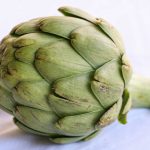 Anyone who has fondled her way through a boiled, buttered artichoke knows that this vegetable is made up of an edible, fleshy base called the heart and an inedible, hairy core called the choke. In fact, most people suppose that the socalled heart and choke of the plant gave the artichoke its name. Actually, the reverse is true: the word artichoke came first, entering English in the early sixteenth century, and only afterwards did its edible and inedible parts come to be known, in the early eighteenth century, as the heart and choke. In other words, after noticing that the word artichoke sounded vaguely like heart and choke, people mistakenly concluded that heart and choke must be the correct and original names for those two parts of the vegetable. This conclusion probably seemed all the more reasonable because you would indeed choke if you tried to eat an artichoke’s tough, fibrous core. More ingenious explanations for the vegetable’s name were also proposed, but they were equally mistaken. Some past horticulturalists, for instance, supposed that the artichoke took its name from hortus—the Latin word for garden—and choke because the plant was reputed to run wild and choke a garden. French etymologists, too, were once stymied by the French name for the vegetable, artichaut: they proposed that the chaut part came from chaud, meaning hot, or even from chou, meaning cabbage. The real origin of artichoke is much simpler than these false etymologies: the word comes from the Arabic al kharshuf, meaning the thistle, because an artichoke is actually the flower bud of a thistle picked before it blooms. This Arabic word was borrowed by Spanish as alcachofa, which was corrupted by Italian as articiocco, which was borrowed by French as artichaut, which was adopted by English as artichoke.
Anyone who has fondled her way through a boiled, buttered artichoke knows that this vegetable is made up of an edible, fleshy base called the heart and an inedible, hairy core called the choke. In fact, most people suppose that the socalled heart and choke of the plant gave the artichoke its name. Actually, the reverse is true: the word artichoke came first, entering English in the early sixteenth century, and only afterwards did its edible and inedible parts come to be known, in the early eighteenth century, as the heart and choke. In other words, after noticing that the word artichoke sounded vaguely like heart and choke, people mistakenly concluded that heart and choke must be the correct and original names for those two parts of the vegetable. This conclusion probably seemed all the more reasonable because you would indeed choke if you tried to eat an artichoke’s tough, fibrous core. More ingenious explanations for the vegetable’s name were also proposed, but they were equally mistaken. Some past horticulturalists, for instance, supposed that the artichoke took its name from hortus—the Latin word for garden—and choke because the plant was reputed to run wild and choke a garden. French etymologists, too, were once stymied by the French name for the vegetable, artichaut: they proposed that the chaut part came from chaud, meaning hot, or even from chou, meaning cabbage. The real origin of artichoke is much simpler than these false etymologies: the word comes from the Arabic al kharshuf, meaning the thistle, because an artichoke is actually the flower bud of a thistle picked before it blooms. This Arabic word was borrowed by Spanish as alcachofa, which was corrupted by Italian as articiocco, which was borrowed by French as artichaut, which was adopted by English as artichoke.
